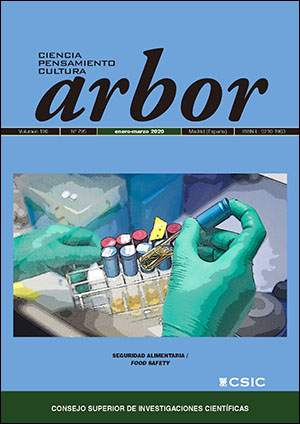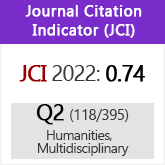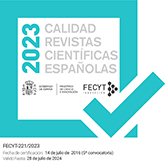Bacteriófagos y endolisinas en la industria alimentaria
DOI:
https://doi.org/10.3989/arbor.2020.795n1008Palabras clave:
bacteriófago, endolisina, antimicrobiano, resistencia antimicrobiana, bacteria patógena, sostenibilidadResumen
La obtención de alimentos sanos y seguros requiere de técnicas de conservación inocuas para el consumidor y para el medio ambiente, entre las que se destaca la bioconservación. A su catálogo de compuestos naturales o microorganismos, utilizados de forma habitual, la bioconservación ha incorporado recientemente los bacteriófagos (fagos) y las proteínas fágicas con actividad lítica (endolisinas). La utilización de fagos y endolisinas en el biocontrol ofrece importantes ventajas frente a otros sistemas de conservación tradicionales. Entre dichas ventajas destacan su inocuidad, especificidad y versatilidad. Por otra parte, la acuciante necesidad de reducir el uso de antibióticos en la cadena alimentaria ha impulsado la investigación basada en estos antimicrobianos con el fin de aplicarlos en producción primaria (terapia fágica). Sin embargo, y a pesar de la gran eficacia ya demostrada en múltiples sectores, la falta de legislación de la Unión Europea sobre el uso de bacteriófagos junto con la necesidad de ser aceptados por los consumidores, son factores que están afectando negativamente a su implantación como bioconservantes. En este contexto, este artículo recoge los últimos resultados relacionados con este tipo de antimicrobianos en la industria agro-alimentaria, y resume los puntos clave para entender las posibilidades reales de su aplicación ante los nuevos requisitos asociados con una producción sostenible tanto desde una perspectiva económica como ambiental
Descargas
Citas
Ackermann, H. W. (2007). 5500 Phages examined in the electron microscope. Archives of Virology, 152, pp. 227-243. https://doi.org/10.1007/s00705-006-0849-1 PMid:17051420
Bigwood, T., Hudson, J. A., Billington, C., Carey-Smith, G. V. y Heinemann, J. A. (2008). Phage inactivation of foodborne pathogens on cooked and raw meat. Food Microbiolology, 25, pp. 400-406. https://doi.org/10.1016/j.fm.2007.11.003 PMid:18206783
Bore, E., Hebraud, M., Chafsey, I., Chambon, C., Skjaeret, C., Moen, B. y Langsrud, S. (2007). Adapted tolerance to benzalkonium chloride in Escherichia coli K-12 studied by transcriptome and proteome analyses. Microbiology 153, pp. 935-946. https://doi.org/10.1099/mic.0.29288-0 PMid:17379704
Briers, Y. y Lavigne, R. (2015). Breaking barriers: expansion of the use of endolysins as novel antibacterials against Gram-negative bacteria. Future Microbiology, 10, pp. 377-390. https://doi.org/10.2217/fmb.15.8 PMid:25812461
Bruttin, A. y Brussow, H. (2005). Human volunteers receiving Escherichia coli phage T4 orally: a safety test of phage therapy. Antimicrobial Agents and Chemotherapy, 49, pp. 2874-2878. https://doi.org/10.1128/AAC.49.7.2874-2878.2005 PMid:15980363 PMCid:PMC1168693
Brüssow, H. y Kutter, E. (2005). Phage ecology. En: Kutter, E. y Sulakvelidze, A. (eds.). Bacteriophages: Biology and Application. Boca Raton, Florida: CRC Press, pp. 129-164. https://doi.org/10.1201/9780203491751.ch6
Carvalho, C., Costa, A. R., Silva, F. y Oliveira, A. (2017). Bacteriophages and their derivatives for the treatment and control of food-producing animal infections. Critical Reviews in Microbiology, 43, pp. 583-601. https://doi.org/10.1080/1040841X.2016.1271309 PMid:28071145
Catalao, M. J., Gil, F., Moniz-Pereira, J., Sao- Jose, C. y Pimentel, M. (2013). Diversity in bacterial lysis systems: bacteriophages show the way. FEMS Microbiology Reviews, 37, pp. 554-571. https://doi.org/10.1111/1574-6976.12006 PMid:23043507
Donovan, D. M., Lardeo, M. y Foster- Frey, J. (2006). Lysis of staphylococcal mastitis pathogens by bacteriophage phi11 endolysin. FEMS Microbiology Letters, 265, pp. 133-139. https://doi.org/10.1111/j.1574-6968.2006.00483.x PMid:17054440
European Food Safety Authority and European Centre for Disease Prevention and Contro (EFSA and ECDC) (2017). The European Union summary report on trends and sources of zoonoses, zoonotic agents and food-borne outbreaks in 2016. EFSA Journal, 15 (12), e05077. https://doi.org/10.2903/j.efsa.2017.5077 PMid:32625371
Endersen, L., O'Mahony, J., Hill, C., Ross, R. P., McAuliffe, O. y Coffey, A. (2014). Phage therapy in the food industry. Annual Review of Food Science and Technology, 5, pp. 327-349. https://doi.org/10.1146/annurev-food-030713-092415 PMid:24422588
Fan, J., Zeng, Z., Mai, K., Yang, Y., Feng, J., Bai, Y., Sun, B., Xie, Q., Tong, Y. y Ma, J. (2016). Preliminary treatment of bovine mastitis caused by Staphylococcus aureus, with trx-SA1, recombinant endolysin of S. aureus bacteriophage IME-SA1. Veterinary Microbiology, 191, pp. 65-71. https://doi.org/10.1016/j.vetmic.2016.06.001 PMid:27374909
Fischetti, V. A. (2008). Bacteriophage lysins as effective antibacterials. Current Opinion in Microbiology, 11, pp. 393-400. https://doi.org/10.1016/j.mib.2008.09.012 PMid:18824123 PMCid:PMC2597892
Gaeng, S., Scherer, S., Neve, H. y Loessner, M. J. (2000). Gene cloning and expression and secretion of Listeria monocytogenes bacteriophage-lytic enzymes in Lactococcus lactis. Applied and Environmental Microbiology, 66, pp. 2951-2958. https://doi.org/10.1128/AEM.66.7.2951-2958.2000 PMid:10877791 PMCid:PMC92096
Gómez-Torres, N., Ávila, M., Narbad, A., Mayer, M. J. y Garde, S. (2019). Use of fluorescent CTP1L endolysin cell wall-binding domain to study the evolution of Clostridium tyrobutyricum during cheese ripening. Food Microbiology, 78, pp. 11-17 https://doi.org/10.1016/j.fm.2018.09.018 PMid:30497591
Gómez-Torres, N., Dunne, M., Garde, S., Meijers, R., Narbad, A., Ávila, M. y Mayer, M. J. (2018). Development of a specific fluorescent phage endolysin for in situ detection of Clostridium species associated with cheese spoilage. Microbial Biotechnology, 11, pp. 332-345. https://doi.org/10.1111/1751-7915.12883 PMid:29160025 PMCid:PMC5812242
Gutiérrez, D., Rodríguez-Rubio, L., Martínez, B., Rodríguez, A. y García, P. (2016). Bacteriophages as weapons against bacterial biofilms in the food industry. Frontiers in Microbiology, 7, 825. https://doi.org/10.3389/fmicb.2016.00825
Hagens, S. y Loessner, M. J. (2007). Application of bacteriophages for detection and control of foodborne pathogens. Applied Microbiology and Biotechnology, 76, pp. 513-519. https://doi.org/10.1007/s00253-007-1031-8 PMid:17554535
Ibarra-Sánchez, L. A., Van Tassell, M. L. y Miller, M. J. (2018). Antimicrobial behavior of phage endolysin PlyP100 and its synergy with nisin to control Listeria monocytogenes in Queso Fresco. Food Microbiology, 72, pp. 128-134. https://doi.org/10.1016/j.fm.2017.11.013 PMid:29407389
Kretzer, J. W., Schmelcher, M. y Loessner, M. J. (2018). Ultrasensitive and fast diagnostics of viable Listeria cells by CBD magnetic separation combined with A511: luxAB detection. Viruses, 10 (11), 626. https://doi.org/10.3390/v10110626 PMid:30428537 PMCid:PMC6266503
Kutter, E., De Vos, D., Gvasalia, G., Alavidze, Z., Gogokhia, L., Kuhl, S. y Abedon, S. T. (2010). Phage therapy in clinical practice: treatment of human infections. Current Pharmaceutical Biotechnology, 11, pp. 69-86. https://doi.org/10.2174/138920110790725401 PMid:20214609
Kutter, E. M., Kuhl, S. J. y Abedon, S. T. (2015). Re-establishing a place for phage therapy in western medicine. Future Microbiology, 10, pp. 685-688. https://doi.org/10.2217/fmb.15.28 PMid:26000644
Loessner, M. J. (2005). Bacteriophage endolysins--current state of research and applications. Current Opinion in Micro biology, 8, pp. 480-487. https://doi.org/10.1016/j.mib.2005.06.002 PMid:15979390
López, R., García, E., García, P. y García, J. L. (1997). The pneumococcal cell wall degrading enzymes: a modular design to create new lysins? Microbial Drug Resistance, 3, pp. 199-211. https://doi.org/10.1089/mdr.1997.3.199 PMid:9185148
Manrique, P., Dills, M. y Young, M. J. (2017). The human gut phage community and its implications for health and disease. Viruses, 9 (6), 141. https://doi.org/10.3390/v9060141 PMid:28594392 PMCid:PMC5490818
Misiou, O., van Nassau, T. J., Lenz, C. A. y Vogel, R. F. (2018). The preservation of Listeria-critical foods by a combination of endolysin and high hydrostatic pressure. International Journal of Food Microbiology, 266, pp. 355-362. https://doi.org/10.1016/j.ijfoodmicro.2017.10.004 PMid:29074196
Moye, Z. D., Woolston, J. y Sulakvelidze, A. (2018). Bacteriophage applications for food production and processing. Viruses, 10 (4), 205. https://doi.org/10.3390/v10040205 PMid:29671810 PMCid:PMC5923499
Obeso, J. M., Martínez, B., Rodríguez, A. y García, P. (2008). Lytic activity of the recombinant staphylococcal bacteriophage PhiH5 endolysin active against Staphylococcus aureus in milk. International Journal of Food Microbiology, 128, pp. 212-218. https://doi.org/10.1016/j.ijfoodmicro.2008.08.010 PMid:18809219
Richter, L., Janczuk-Richter, M., Niedziolka-Jonsson, J., Paczesny, J. y Holyst, R. (2018). Recent advances in bacteriophage-based methods for bacteria detection. Drug Discovery Today, 23, pp. 448-455. https://doi.org/10.1016/j.drudis.2017.11.007 PMid:29158194
Rodríguez-Rubio, L., Gutiérrez, D., Martínez, B., Rodríguez, A. y García, P. (2012). Lytic activity of LysH5 endolysin secreted by Lactococcus lactis using the secretion signal sequence of bacteriocin Lcn972. Applied and Environmental Microbiology, 78, pp. 3469-3472. https://doi.org/10.1128/AEM.00018-12 PMid:22344638 PMCid:PMC3346474
Rodríguez-Rubio, L., Martínez, B., Donovan, D. M., García, P. y Rodríguez, A. (2013). Potential of the virion-associated peptidoglycan hydrolase HydH5 and its derivative fusion proteins in milk biopreservation. PLoS One, 8, e54828. https://doi.org/10.1371/journal.pone.0054828 PMid:23359813 PMCid:PMC3554637
Rodríguez-Rubio, L., Martínez, B., Rodríguez, A., Donovan, D. M., Gotz, F. y García, P. (2013). The phage lytic proteins from the Staphylococcus aureus bacteriophage vB_SauS-phiIPLA88 display multiple active catalytic domains and do not trigger staphylococcal resistance. PLoS One, 8, e64671. https://doi.org/10.1371/journal.pone.0064671 PMid:23724076 PMCid:PMC3665550
Sao-Jose, C., Parreira, R., Vieira, G. y Santos, M. A. (2000). The N-terminal region of the Oenococcus oeni bacteriophage fOg44 lysin behaves as a bona fide signal peptide in Escherichia coli and as a cis-inhibitory element, preventing lytic activity on oenococcal cells. Journal of Bacteriology, 182, pp. 5823-5831. https://doi.org/10.1128/JB.182.20.5823-5831.2000 PMid:11004183 PMCid:PMC94706
Sarker, S. A., McCallin, S., Barretto, C., Berger, B., Pittet, A. C., Sultana, S., Krause, L., Huq, S., Bibiloni, R., Bruttin, A., Reuteler, G. y Brussow, H. (2012). Oral T4-like phage cocktail application to healthy adult volunteers from Bangladesh. Virology, 434, pp. 222-232. https://doi.org/10.1016/j.virol.2012.09.002 PMid:23102968
Schmelcher, M., Donovan, D. M. y Loessner, M. J. (2012). Bacteriophage endolysins as novel antimicrobials. Future Microbiology, 7, pp. 1147-1171. https://doi.org/10.2217/fmb.12.97 PMid:23030422 PMCid:PMC3563964
Scholte, C. M., Nelson, D. C., Garcia, M., Linden, S. B., Elsasser, T. H., Kahl, S., Qu, Y. y Moyes, K. M. (2018). Short communication: Recombinant bacteriophage endolysin PlyC is nontoxic and does not alter blood neutrophil oxidative response in lactating dairy cows. Journal of Dairy Science, 101, pp. 6419-6423. https://doi.org/10.3168/jds.2017-13908 PMid:29729914
Schuch, R., Nelson, D. y Fischetti, V. A. (2002). A bacteriolytic agent that detects and kills Bacillus anthracis. Nature, 418, pp. 884-889. https://doi.org/10.1038/nature01026 PMid:12192412
Sulakvelidze, A. (2013). Using lytic bacteriophages to eliminate or significantly reduce contamination of food by foodborne bacterial pathogens. Journal of the Science of Food and Agriculture, 93, pp. 3137-3146. https://doi.org/10.1002/jsfa.6222 PMid:23670852
Sulakvelidze, A. y Kutter, E. (2005). Bacteriophage therapy in humans. En: Kutter, E. y Sulakvelidze, A. (eds.). Bacteriophages: biology and application. Boca Raton, Florida: CRC Press, pp. 381-436. https://doi.org/10.1201/9780203491751.ch14 PMid:14715765 PMCid:PMC321703
Recursos en línea
Centers for Disease Control and Prevention (CDC). Foodborne Diseases Active Surveillance Network (FoodNet): FoodNet 2015 Annual Foodborne Illness Surveillance Report. [En línea]. Disponible en https://www.cdc.gov/foodnet/reports/annual-reports-2015.html
Publicado
Cómo citar
Número
Sección
Licencia
Derechos de autor 2020 Consejo Superior de Investigaciones Científicas (CSIC)

Esta obra está bajo una licencia internacional Creative Commons Atribución 4.0.
© CSIC. Los originales publicados en las ediciones impresa y electrónica de esta Revista son propiedad del Consejo Superior de Investigaciones Científicas, siendo necesario citar la procedencia en cualquier reproducción parcial o total.Salvo indicación contraria, todos los contenidos de la edición electrónica se distribuyen bajo una licencia de uso y distribución “Creative Commons Reconocimiento 4.0 Internacional ” (CC BY 4.0). Puede consultar desde aquí la versión informativa y el texto legal de la licencia. Esta circunstancia ha de hacerse constar expresamente de esta forma cuando sea necesario.
No se autoriza el depósito en repositorios, páginas web personales o similares de cualquier otra versión distinta a la publicada por el editor.















